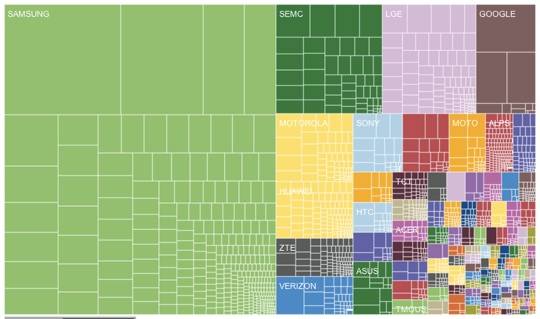
The topic of Android fragmentation has once again returned. This time around the talk has come by way of the recently published Android Fragmentation Visualized report from OpenSignal. This report is taking a look at fragmentation as both a strength and weakness and while there is quite a bit of information available, we cannot help but overlook how this details the dominance of Samsung. But first, some other interesting numbers from the report.
The total number of devices surveyed for this report was 682,000. Furthermore, it lists 3,997 devices as being seen last year and 11,868 as having been seen this year. The ‘seen’ factor is determined by the devices that access the OpenSignal app. While it is clear that OpenSignal has seen many more unique devices this year (as opposed to last year), the more interesting aspect comes in with the fact that this year is only half over.
Basically, this points towards the amount of devices as having roughly tripled and we still have half the year left. This brings one item that the the OpenSignal report is touting as an advantage. They mention how “availability of cheap Android phones (rarely running the most recent version) means that they have a much greater global reach than iOS, so app developers have a wider audience to build for.”
They do mention this may be “tricky to do” but also go on to mention that fragmentation is a benefit for users as well. In this case the report talks about how this means users should be able to get exactly what they want. This includes everything from screen size to price and any combination in between.

Of course, we suspect many think of fragmentation in terms of the version of Android. Or specifically, as compared to the versions of iOS. In this case the report shows eight versions of Android currently in use with 37.9 percent of users with Jelly Bean. Breaking that down further and we see Android 4.1.x with 32.3 percent and Android 4.2.x with 5.6 percent. And then, while likely still very small, there is now also Android 4.3 to consider. As compared to iOS, that currently sits with three versions of which 95 percent of users are running the most recent.
Shifting back to the talk of Samsung though, this report has them pegged with 47.5 percent of the market share. That by itself speaks quite a bit. The top Samsung device according to this report is the Galaxy S III, though the Galaxy S II still rates fairly high in the rankings. Other notable Samsung devices sitting close to the top include the Galaxy Note II, Galaxy Y, Galaxy S Advance, Galaxy S 4 and the Galaxy Tab (GT-P3100) tablet. Notice the wide variety of sizes and prices here.
Bottom line here, while the OpenSignal report highlights the positive and negative of Android fragmentation, we cannot help but notice the connection between how Samsung has countless devices across a wide variety of sizes and prices. This brings back the earlier point (from OpenSignal) about how this is good for consumers, and well, in that respect it looks like Samsung may be doing something right. Or on the flip side, causing the issue of fragmentation to grow single-handedly.
SOURCE: OpenSignal










Holy crap, Samsung is like a bull in a fragmented OS china shop!
Yea. They make every size under the sun.
47.5 market share wow… This goes right to what I have always said. Samsung is android period